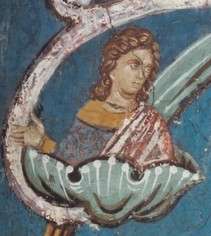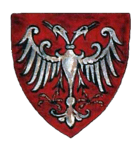Urošica
| Saint Urošica | |
|---|---|
 Fresco in the Visoki Dečani monastery | |
| Native name | Стефан Урошица Немањић |
| Church | Serbian Orthodox |
| Personal details | |
| Born | before 1285 |
| Died | before 1316[1] |
| Buried | Saint Achillius Church, Arilje (Serbia) |
| Nationality | Serb |
| Denomination | Eastern Christianity |
| Parents | Stefan Dragutin and Catherine of Hungary |
| Coat of arms |
 |
| Sainthood | |
| Feast day | November 11 [O.S. November 24] |
| Canonized |
before 1378 by Serbian Orthodox Church |
Urošica (Serbian Cyrillic: Урошица[a]; fl. 1285 – before 1316) was a Serbian prince and Orthodox monk, a member of the Nemanjić dynasty. He was the younger son of Stefan Dragutin, King of Serbia 1272–1282 and Syrmia 1282–1316. Dragutin kept Syrmia after passing the rule to Stefan Milutin in 1282. Through mother Catherine of the Hungarian Árpád dynasty, the elder son Stefan Vladislav II was the Duke of Slavonia from 1292 and the King of Syrmia from 1316 until 1325. Urošica took monastic vows as Stefan (Стефан), and is venerated as a saint by the Serbian Orthodox Church on November 11 [O.S. November 24].
Life
Family and political background
Urošica was the youngest of three children of Serbian King Stefan Dragutin and Catherine, a Hungarian princess.[2]
There is a theory that Urošica and Urošic are two people.[3][4]
Dragutin ruled from 1276 until he broke his leg while hunting and became ill in 1282, when the rule was passed to Dragutin's younger brother Stefan Milutin, while Dragutin kept Syrmia as King (1282–1316).
Ladislaus IV died in 1290 leaving no sons, and a civil war between rival candidates Andrew III of Hungary, and Charles Martel of Anjou started.[5] Through mother Catherine of the Hungarian Árpád dynasty, brother Stefan Vladislav II received the duchy of Slavonia in 1292.[6] In 1293, Vladislav married Constanza Morosini, a relative of Andrew III on his maternal side.[6] Charles Martel was supported by Croatian nobleman Paul I Šubić of Bribir, who received the right to Gvozd and Neretva rivers after Charles had managed to assert his rule over parts of Croatia.
His sister Elizabeth married Stephen I, Ban of Bosnia (1287–1314), also a Hungarian vassal.[2]
Monastic life
He took monastic vows with the name Stefan, a tradition of the Nemanjić dynasty.[a] The Tavna Monastery on Majevica in Bosnia is thought to be the endowment of Urošica and his brother Vladislav. Some sources claim that the Papraća Monastery located by the Spreča river under the Borogovo mountain was an endowment of the brothers and their father Dragutin.
He died young as a monk sometime before 1316,[b] and was buried in the Saint Achillius Church in Arilje (Serbia), the endowment of his father Dragutin (the church was painted in 1296[7]). According to legend his relics were Myrrh-streaming, thus the Serbian Orthodox Church proclaimed him a saint, venerating him on November 11 [O.S. November 24].[8] Frescoes of him exist at Gračanica, Peć, Visoki Dečani, and Arilje in the narthex on the northern wall.[4][9] None of the frescoes include the title "Saint".[4]
In 1311, Dragutin launched a campaign to seize the throne to his son; this is thought to have meant Vladislav (although Archbishop Danilo II said Urošic was the possible heir).[10]
Ancestry
| Ancestors of Urošica | |||||||||||||||||||||||||||||||||||||||||||||||||||||||||||||||||||||||||||||||||||||||||||||||||||||||||||||||||||||||||||||||||||||||||||||||||||||||||||||||||||||||||||||||||||||||||||||||||||||||||||||||||||||||||||||||||||||||||||||||||||||||||||||||||||||||||||||||||||||||||||||||||||||||||||||||||||||||||||||||||||||||||||||||||||||||||||||||||||||||||||||||||||||||||||||||||||||||||||||||||||||||||
|---|---|---|---|---|---|---|---|---|---|---|---|---|---|---|---|---|---|---|---|---|---|---|---|---|---|---|---|---|---|---|---|---|---|---|---|---|---|---|---|---|---|---|---|---|---|---|---|---|---|---|---|---|---|---|---|---|---|---|---|---|---|---|---|---|---|---|---|---|---|---|---|---|---|---|---|---|---|---|---|---|---|---|---|---|---|---|---|---|---|---|---|---|---|---|---|---|---|---|---|---|---|---|---|---|---|---|---|---|---|---|---|---|---|---|---|---|---|---|---|---|---|---|---|---|---|---|---|---|---|---|---|---|---|---|---|---|---|---|---|---|---|---|---|---|---|---|---|---|---|---|---|---|---|---|---|---|---|---|---|---|---|---|---|---|---|---|---|---|---|---|---|---|---|---|---|---|---|---|---|---|---|---|---|---|---|---|---|---|---|---|---|---|---|---|---|---|---|---|---|---|---|---|---|---|---|---|---|---|---|---|---|---|---|---|---|---|---|---|---|---|---|---|---|---|---|---|---|---|---|---|---|---|---|---|---|---|---|---|---|---|---|---|---|---|---|---|---|---|---|---|---|---|---|---|---|---|---|---|---|---|---|---|---|---|---|---|---|---|---|---|---|---|---|---|---|---|---|---|---|---|---|---|---|---|---|---|---|---|---|---|---|---|---|---|---|---|---|---|---|---|---|---|---|---|---|---|---|---|---|---|---|---|---|---|---|---|---|---|---|---|---|---|---|---|---|---|---|---|---|---|---|---|---|---|---|---|---|---|---|---|---|---|---|---|---|---|---|---|---|---|---|---|---|---|---|---|---|---|---|---|---|---|---|---|---|---|---|---|---|---|---|---|---|---|---|---|---|---|---|---|---|---|---|---|---|---|---|---|---|---|---|---|---|---|---|---|---|---|---|---|---|---|---|---|---|---|---|---|---|
| |||||||||||||||||||||||||||||||||||||||||||||||||||||||||||||||||||||||||||||||||||||||||||||||||||||||||||||||||||||||||||||||||||||||||||||||||||||||||||||||||||||||||||||||||||||||||||||||||||||||||||||||||||||||||||||||||||||||||||||||||||||||||||||||||||||||||||||||||||||||||||||||||||||||||||||||||||||||||||||||||||||||||||||||||||||||||||||||||||||||||||||||||||||||||||||||||||||||||||||||||||||||||
Annotations
- ^ Name: His given name was Urošica or Urošic (Урошиц/a), a diminutive of the name Uroš (with suffix -ica, literally "Little Uroš",[11] after grandfather Stephen Uroš I of Serbia). He took monastic vows with the name Stefan; a tradition of the Nemanjić dynasty used since Stefan Nemanja until the last ruler.[12][13] He was proclaimed a saint by the Serbian Church, and is referred to as "Saint Urošica" (Св. Урошица).[8]
References
- ↑ Stanojević 1925, p. 47
Sinovi Uroševi bijahu: Dragutin (kralj srpski 1276 do 1282, srijemski 1284—1316) i Milutin (kralj 1282—1321), Dragutinovi sinovi su Urošic ( — prije 1316) i Vladislav (kraljevski pretendent 1321—1324). Njihova linija izumrla je ili se izgubila.
- 1 2 Mileusnić 2000, p. 64
Кад је стасао за же- нидбу венчао се са Кателином (Катлин), кћерком угарског краља Сте- Љана V, са којом је имао синове Владислава и Урошица, и кћер Јелену (Јелисавету) која се 1284. године удала за босанског бана ...
- ↑ Yugoslav National Committee for Historical Studies 1955, p. 140
O jednoj genealoskoj pogresci: Urosic nije Urosica — IP, 2, 19.54, p. 61 — 62). L'auteur montre comment Urošic, fils de Dra- gutin, a été identifié par erreur avec Urosica, puis il analyse à nouveau les sources selon lesquelles Urosic se fait moine sous ...
- 1 2 3 Pavlović 1965, pp. 235–237
p. 235: [...] p. 236: ту се помигье гроб Урошица. Да ли ]'е он овде или на другом месту, не зна се. Поред ]ужне фасаде цркве данас се налази ]едан такоЬе празан саркофаг, ко]и ]е премештен (сл. 24). Где ]е он првобитно поставлен и са чидим телом [...] p. 237: Фресколик Урошица налази се у „лози Немањића" у Грача- ници, Пећи, Дечанима, а у Ариљу у припрати на северном зиду. На њима се не налази натпис са називом „свети".
- ↑ Fine 1994, pp. 207–208
- 1 2 Младен Лесковац; Александар Форишковић; Чедомир Попов (2004). Српски биографски речник: Volume 2. Будућност. p. 245.
Отац је право наслеђа настојао сачувати за старијег сина Урошица. Преко мајке Влади- слав је био повезан са угарском династијом, те је 1 292. добио наследно херцештво Славонију. Сле- деће године склопљен је брачни ...
- ↑ Kovačević, Jovan (1953). Srednjovekovna nošnja balkanskih slovena: studija iz istorije srednjovekovne kulture Balkana. Naučna knjiga. p. 37.
Портрети Владислава и Урошица, по Св. Радојчићу, радила је друга рука. Црква је живописана 1296 год.
- 1 2 Srpska pravoslavna crkva. Sveti arhijerejski sinod, p. 55
Урошица (Св. Урошица, кнез српски)
- ↑ Fondation Byzantine 2002, p. 465
- ↑ Vásáry 2005, pp. 110; Јеротић 2002, p. 12
краља Милутина напао брат Драгутин да би отео престо за сина Урошица
- ↑ Jugoslavenska akademija znanosti i umjetnosti 1971, p. 820
UROšIC, m. dem. od Uroš; mali, mladi, Uroš. Be bo vfazdviglb se bratb tomu (t. j. kra- \u Vrošu) Stefanb kralb . . . hote vbzbmb pre- stolb jego dati »ynu svojemu Urošicu. Danilo 357. Rodi že i syna dva (Slefan kra\) Vladisla- va krala i Uroiica.
- ↑ Srpska akademija nauka i umetnosti 1959, p. 203
- ↑ Maguire 2004, pp. 61–62
Sources
- Fondation Byzantine (2002). Byzantion: revue internationale des études byzantines, Volume 72, Issue 2. Fondation Byzantine.
- Jugoslavenska akademija znanosti i umjetnosti (1971). Đura Daničić; Pero Budmani; Matija Valjavac, eds. Rječnik hrvatskoga ili srpskoga jezika, Volume 19 (in Serbo-Croatian). U kńižarnici L. Hartmana.
- Maguire, Henry (2004). Byzantine court culture from 829 to 1204. Dumbarton Oaks. ISBN 978-0-88402-308-1.
- Pavlović, Leontije (1965). Kultovi lica kod Srba i Makedonaca (in Serbian). Narodni muzej Smederevo.
- Srpska akademija nauka i umetnosti (1959). Glasnik, Volume 11 (in Serbian). Srpska akademija nauka i umetnosti.
- Srpska pravoslavna crkva. Sveti arhijerejski sinod (2001). Službeni list Srpske pravoslavne crkve , Volume 83. Srpska pravoslavna crkva.
- Stanojević, Stanoje (1925). Narodna enciklopedija srpsko-hrvatsko-slovenac̆ka, Volume 3. Izdavac̆: Bibliografski zavod d.d.
- Vásáry, István. Cumans and Tatars: Oriental military in the pre-Ottoman Balkans, 1185-1365. p. 110.
- Yugoslav National Committee for Historical Studies (1955). Jorjo Tadić, ed. Ten years of Yugoslav historiography, 1945-1955. Publishing Enterprise "Jugoslavija".